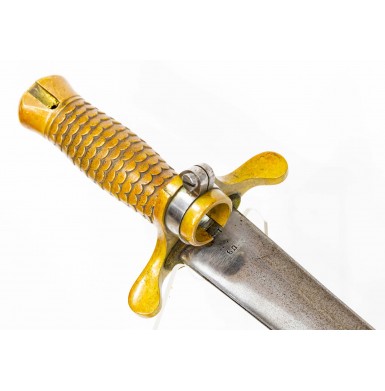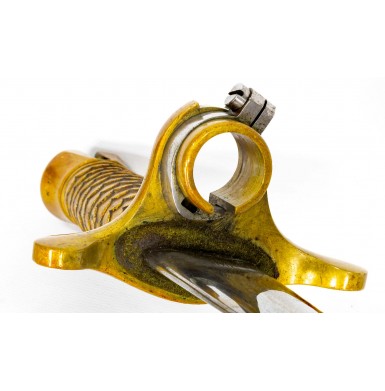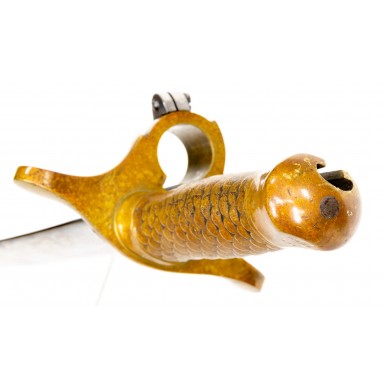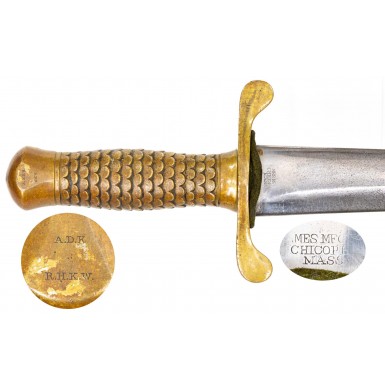Fine 1855-Dated US Model 1847 Sappers & Miners Saber Bayonet
- Product Code: EWB-2261-SOLD
- Availability: Out Of Stock
-
$1.00
In March of 1847, the U.S. Ordnance Board approved the adoption of three smooth bore percussion musketoons for the use of the Artillery, Cavalry, and Sapper & Miners (Engineers). The guns were based upon the current M1842 percussion musket then in service with the infantry, and were of .69 caliber smoothbore arms, as was the M1842. The musketoons had a lock that was quite similar to the M1842 in profile and design, but appropriately smaller for the musketoon’s size. The furniture for the Artillery and Sappers & Miners musketoon was based upon that of the M1842 musket, and like the musket was made of iron. The furniture for the Cavalry musketoon was of the same general pattern but made of brass. While the cavalry musketoon had no need for a bayonet, the artillery and engineer carbines did. The artillery carbine had a stud under the barrel allowing it to accept the standard US M1835 socket bayonet in use with the M1842 musket. The Sappers & Miners musketoon, however, was to accept a saber bayonet that would be able to double as a useful tool for the engineers. The bayonet was designed by N.P. Ames, Jr., who based the blade upon that of the US M1832 Foot (Heavy) Artillery sword that was then in production at their factory. While the M1832 sword, which was based upon the Roman Gladius, was a functional weapon, it was really intended for use as a falchion or multipurpose tool for the artilleryman. The sword could be used for everything from a machete to clear brush, a hatchet to make gabions, chevaux-de-frise and similar improvised fortifications, a field-expedient shovel for digging gun emplacements, and yes, even as a weapon! Using the sword as his basis for design, Ames contacted the Ordnance Department in a letter dated 19 June 1846 stating:
“We have a model underway for a sword for the musketoon...which will be forwarded for your examination as soon as completed. It requires a little to mature a way for attaching it; our present plan is to put a stud on the upper (musketoon barrel) band that will fit a corresponding groove in the end of the (saber bayonet) hilt; a band or ring to project from the guard and fit on the end of the barrel....”
The prototype bayonet was completed on 16 July 1846 and delivered to the Ordnance Department in Washington D.C. by Ames himself in August of that year. In December the Ordnance Department placed their first order for the bayonets from Ames, and in a letter dated 21 December 1846 Lt. Colonel George Talcott of the Ordnance Department contacted Ames, saying:
“Sir, You are requested to furnish a quantity of swords differing somewhat from the Artillery swords heretofore furnished. Major (James Wolfe) Ripley has the pattern and states that two hundred (200) will shortly be required. It is probable that several thousand will be wanted hereafter as they are destined to be fixed on the Musketoon to serve the purpose of a bayonet but are habitually worn in a scabbard like the Artillery Sword. Be pleased to name the price at which you will agree to furnish them subject to inspection and the time when 200 can be supplied.”
On 25 December 1846 Ames, who apparently did not take the day off for Christmas, sent a letter to Talcott noting that 50 of the bayonets would be ready shortly, but that he would rather not set a price until all 200 had been produced, for at that point he could more fairly judge the actual cost of production. This implied that setting the price based upon the short run would inherently mean a higher price than after making a larger quantity of the bayonets. While I do not have the correspondence at hand, noted researcher and author Paul Johnson has stated that he acquired a letter which states that these first 200 bayonets for the Sappers & Miners musketoons were delivered in component form, the blades being delivered first and the hilts at some later time. I do not know if this production issue revolved around the casting of the brass hilt, or some delay in finalizing the attachment method (or the means to machine and manufacture it) for the hilt. Mr. Johnson notes that the blades and hilts for the first 200 bayonets were assembled at Springfield Arsenal and that is why the blades are undated and do not bear the usual inspection marks associated with other Sappers & Miners bayonets. The first 200 bayonet blades included a narrow fuller in the center of the wasp-waisted blade. For some reason the Ordnance Department did not like this feature, and when ordering additional bayonets in February of 1847, they sent Ames a letter stating:
“You will be pleased to furnish this Department with three hundred swords for the musketoons, in addition to the 200 already made, leaving out the grooves in the blades.”
Clearly Ames had anticipated additional orders and had produced more than the initial 200 blades during his first production run, thus some additional blades with fullers were still in his inventory when the second order was received. He wrote to the Ordnance Department appraising them of that fact, and in view of the extra cost that might be incurred by refusing to accept the blades that had already been manufactured, Lt. Colonel Talcott responded on 15 March 1847:
“Sir, Your letter of the 12th instance is received indicating that the blades of Musketoon swords should be made without grooves. The Board has in view only convenience & economy in the manufacture of them - there is not the least objection to taking 50 or any number with grooves if they have been provided.”
As a result, between 50 and 100 additional grooved blade M1847 Sappers & Miners bayonets were delivered by Ames as part of his second contract. This second order for bayonets was delivered in May of 1847, making a total of 500 M1847 bayonets delivered that year. Additional M1847 saber bayonets would not be ordered until 1855, when on January 26 another 500, complete with scabbards and without fullers in their blades, were ordered for the Ordnance Department. These bayonets were delivered in May of 1855. A final order for 33 US M1847 Sappers & Miners Bayonets was placed on November 23, 1855, with the bayonets to be delivered to Springfield for issue to the state of New York. These bayonets were delivered in April of 1856. In all it appears that only 1,033 of these bayonets were manufactured, 500 in 1847 and 533 in 1855-1856. To date, only the dates 1847 and 1855 have been noted on the blades of extant examples.
Like the M1832 Foot Artillery Sword, the M1847 Sappers & Miners Bayonet had a Roman Gladius style wasp-waisted, spear point blade, with a brass hilt cast with a fish scale grip surface. The blade was 22” long and the first 250-300 of the blades will be encountered with the narrow fuller down the center. The earliest blades, delivered at the beginning of 1847, were marked only US on the reverse ricasso and did not exhibit the usual Ames marks, dates or other inspection marks found on the blades of later production bayonets. The brass grip had a cast-in, fish scale pattern, to improve the grip of the soldier holding it. A buff leather washer was present between the hilt and blade at that juncture, forward of the guard. The guard had two round, forward facing quillons, both above and below the blade, and a large cast muzzle brass muzzle ring, along with a spring steel locking ring. The rear of the hilt was slotted in a "T" shape to engage the bayonet bar on the muzzle of the musketoon. The blade was secured to the hollow cast brass hilt by peening it at the rear of the bulbous pommel cap. Ordinarily the bayonets were marked on the reverse of the pommel cap with an alphanumeric mating code to match the bayonet to the musketoon it had been fit to. This same mating number would be found on the upper portion of the rear most strap of the double-strapped upper barrel band of the musketoon, just forward of the band’s steadying lug. The bayonet was provided with a brass mounted leather scabbard, similar to the one used with the M1832 Foot Artillery Sword.
This is one of the scarce US Model 1847 Sappers & Miners Saber Bayonets that was part of second order in 1855. The bayonet is in about FINE condition overall and has an attractive lightly freckled gray patina over most of the blade, darkening the otherwise relatively bright blade. The bayonet blade bears the usual marks from the second contract, including a US on the reverse ricasso over the inspection initials A.D.K. and the date 1855. The obverse ricasso is marked in three lines: AMES MFG CO / CHICOPEE / MASS. The obverse flat of the pommel cap is marked with two sets of inspection initials. The first are A.D.K., the mark of A.D. King, a long-time arsenal sub-inspector. The second set of initials are R.H.K.W., the mark of US Ordnance Department Major Robert Henry Kirkland Whitely. The top of the pommel cap is marked with the alphanumeric code N 2, which was the mating mark that matched the bayonet to the musketoon to which it was fit. The blade of the bayonet is full-length and has the un-fullered blade of the later production M1847 bayonets. As previously noted, the blade retains some bright polish with a freckled and oxidized gray patina over most of its surface. The blade is mostly smooth, with only some lightly scattered very minor surface oxidation, some tiny patches of very light surface roughness around the blade to hilt joint and a few minor areas of light pinpricking around the throat washer. The photos make the blade look darker than it does in hand, as the contrast between freckled discoloration is made much more pronounced because of the photographic lighting and the white background. The blade was lightly cleaned long ago, and some scuff marks are present on the ricasso under the muzzle ring and the markings in that location are slightly worn. The brass hilt is in very fine condition, with an attractive and completely uncleaned rich, bronze patina. The fish scale grip all remain crisp and sharp, and all of the inspection and mating marks remain clearly visible. The mortise on the rear of the pommel cap is equally sharp and the original locking ring is in place over the guard and functions smoothly. The original buff leather throat washer is present at the blade to hilt juncture and has a thickly oxidized greenish patina from oxidation. The bayonet is 100% original and fully functional but is void of a scabbard.
Overall, this is a very crisp and attractive example of the scarce US Model 1847 Sappers & Miners Bayonet. This bayonet was one of the 533 manufactured by Ames and delivered in 1855. The mating number suggests that this bayonet was latter part of the first quarter of bayonets to be fit to musketoons and then marked. Assuming that the usual arsenal practice of using a letter to represent the first “number” (A=1, B=2, etc.) was use, this bayonet marked “N 2” would be number “142” to be mated to a musketoon. These bayonets and late production Sappers & Miners musketoons had a fairly short service life, as the US M1855 rifle started to replace the M1847 musketoon with the Engineer Corps during 1857-58. If you have an 1855 dated musketoon, this is a must of an accessory for it, and if you are a US bayonet collector is one of those “musket have” bayonets that is very striking in appearance and is always impressive to display.
SOLD
Tags: Fine, 1855-Dated, US, Model, 1847 Sappers, Miners, Saber, Bayonet










